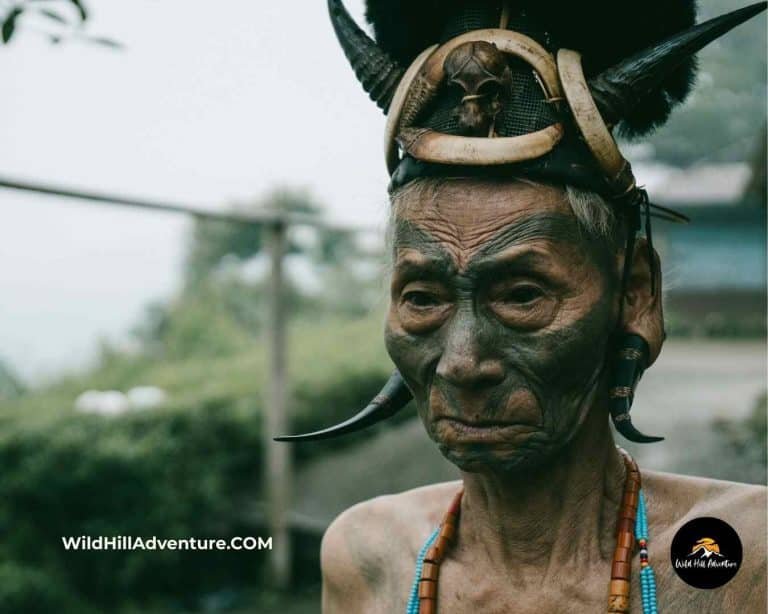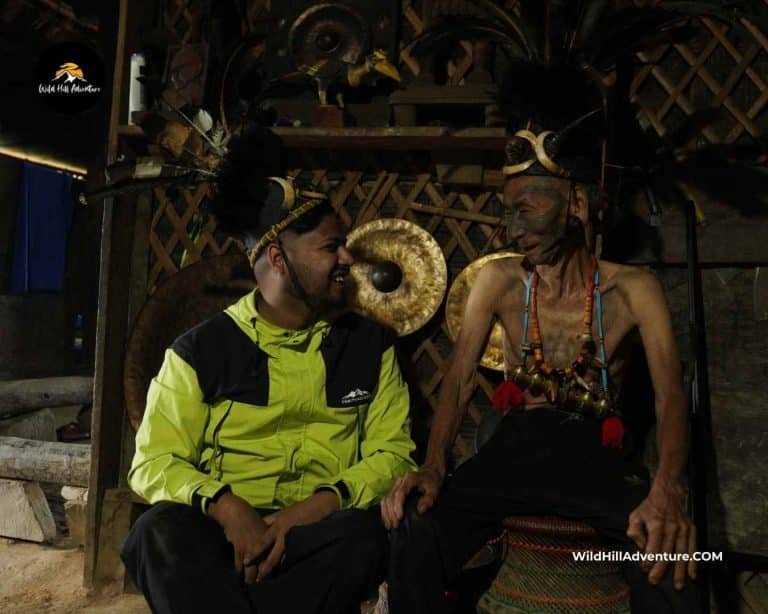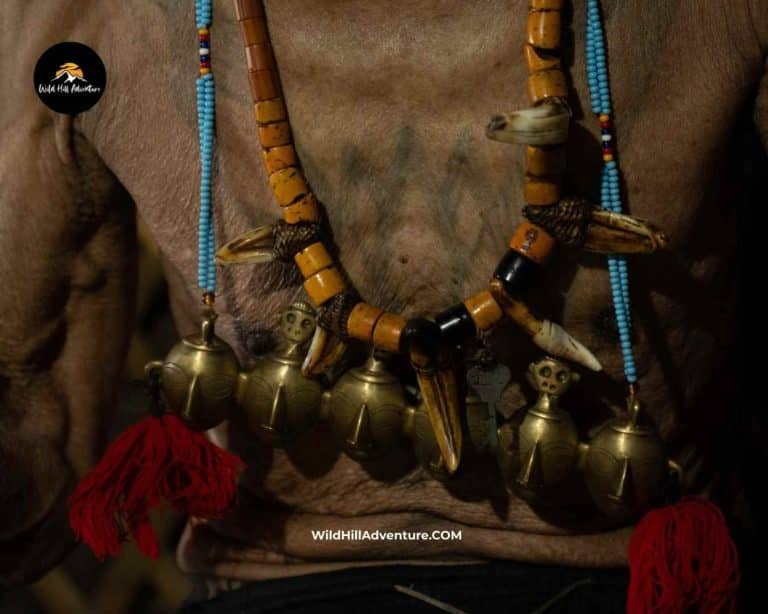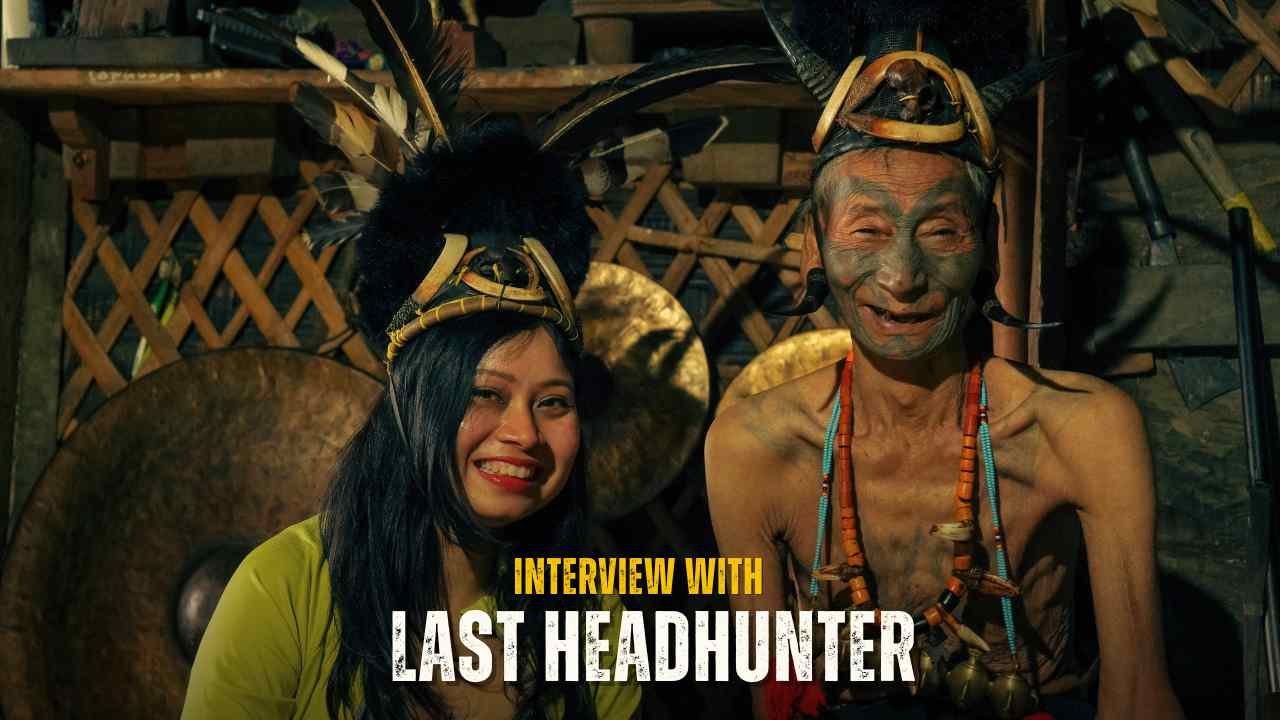Interview with the last living headhunter of Nagaland, Panchum Shakam. Discover Konyak warrior life, tribal love traditions, and Longwa’s vanishing legacy.
Interview with the Last Living Headhunter of Nagaland: Panchum Shakam

Photos of the last living headhunter were clicked by our founder, Noshad. Follow us on Instagram: @wild9sd
In the remote village of Longwa, straddling the Indo-Myanmar border, we had the privilege of conducting an interview with the last living headhunter of Nagaland, Panchum Shakam. At 84, this Konyak warrior carries the weight of a fading era — a time when headhunting defined honor, courage, and tribal legacy.
Meeting Panchum Shakam: A Living Legend

Panchum Shakam and our guide, Nokao, translated the conversation for our guest.
Panchum greeted us with a warm, toothy smile, his presence both gentle and commanding. At first, he seemed like any loving grandfather, playfully engaging with his grandsons. Yet, his facial tattoos — bold and intricate — revealed his past as a headhunter of the Konyak tribe. Adorned with a striking headgear of hornbill feathers, boar tusks, brass, and beads, and a chain with six lockets symbolizing heads taken in battle, Panchum is a living bridge between ancient traditions and modern peace.
Our guide, Mr. Nokhao, facilitated this rare interview with the last living headhunter of Nagaland, allowing us to delve into Panchum’s extraordinary life.
The Legacy of Headhunting in Nagaland
Headhunting was once central to Konyak Naga culture, rooted not in cruelty but in spiritual and social significance. Warriors who claimed enemy heads brought prestige, fertility, and protection to their village. This revered practice persisted until it was banned in 1968.
Panchum’s journey as a warrior began in the 1920s, around age 20–25, following in the footsteps of his father and grandfather. He trained in the Morung, a sacred dormitory where boys aged 5 to 15 learned warfare, tribal customs, and oral traditions. Training included mastering guns, bows, arrows, and the Naga Dao — a fearsome machete used in combat.
Becoming a Headhunter
Selection for headhunters was rigorous. The tribal king chose the most skilled warriors from the Morung, though spontaneous recruitment occurred during rival village attacks. Brave defenders who returned with a head earned the title of headhunter, along with land, houses, and riches. These warriors held immense respect and authority in Konyak society.
Panchum’s journey as a warrior began in the 1920s, around age 20–25, following in the footsteps of his father and grandfather. He trained in the Morung, a sacred dormitory where boys aged 5 to 15 learned warfare, tribal customs, and oral traditions. Training included mastering guns, bows, arrows, and the Naga Dao — a fearsome machete used in combat.
Becoming a Headhunter
Selection for headhunters was rigorous. The tribal king chose the most skilled warriors from the Morung, though spontaneous recruitment occurred during rival village attacks. Brave defenders who returned with a head earned the title of headhunter, along with land, houses, and riches. These warriors held immense respect and authority in Konyak society.
Panchum’s journey as a warrior began in the 1920s, around age 20–25, following in the footsteps of his father and grandfather. He trained in the Morung, a sacred dormitory where boys aged 5 to 15 learned warfare, tribal customs, and oral traditions. Training included mastering guns, bows, arrows, and the Naga Dao — a fearsome machete used in combat.
A Warrior’s Heart: Love and Tradition

Beyond tales of war, Panchum shared stories of love with a twinkle in his eye. At 18, he proposed to his wife using a sacred piece of tree bark — a Konyak courtship tradition. The bark, carefully selected and marked, was sent to the girl’s family. If accepted, a reciprocal gift, such as another piece of bark or a tobacco basket, sealed the bond. These traditions highlight the depth of Konyak culture, where even love carried profound symbolism.
Panchum Shakam: More Than a Warrior
Panchum is not just the last living headhunter of Nagaland; he is a testament to a culture that thrived on myth, honor, and memory. His words resonate like the oldest tree in Longwa — weathered, enduring, sacred. “I was a warrior,” he said, “but also a man who loved deeply.”
This interview with the last living headhunter of Nagaland offers a rare glimpse into a vanishing world, preserved through Panchum’s stories and the vibrant traditions of Longwa.
Why Visit Longwa?

history of warriors like Panchum, this is a place where the past speaks vividly. Visitors can explore:
- Konyak traditions: Witness tattooing ceremonies and traditional crafts.
- Longwa’s unique border: Stand in two countries at once.
- Panchum’s legacy: Meet the man who embodies Nagaland’s warrior past
Best Time to Visit Longwa
Plan your trip between October and April for pleasant weather and vibrant festivals like Aoleang (April), where Konyak culture comes alive.
Month | Weather |
Oct–Nov | Cool, pleasant |
Dec–Feb | Cold, clear |
Mar–Apr | Mild, festive |
Experience Longwa with Wild Hill Adventure
Discover the village of the last living headhunter of Nagaland with Wild Hill Adventure — a local, community-rooted travel company from Northeast India. We’ve proudly hosted over 1,000 Indian travelers and 50+ international guests in Longwa, offering immersive, culturally respectful experiences.
Join us to:
✅ Meet tribal legends like Panchum Shakam
✅ Explore ancient Konyak traditions and tattoos
✅ Stand at the iconic Indo-Myanmar border
✅ Witness the living history of Nagaland’s warrior tribes
📧 Email: wildhilladventure@gmail.com
📱 Call / WhatsApp: +91 93654 76611
📍 Wild Hill Adventure — authentic, local, and born in Northeast India
Book your Longwa journey today and step into a world where history still breathes.
FAQ: Interview with the Last Living Headhunter of Nagaland
While there are still a few surviving headhunters in Nagaland, Panchum Shakam is one of the most well-known and respected elders from Longwa village in Mon district. At 84, Panchum is a legendary Konyak warrior who lived through the era when headhunting was a part of tribal tradition and honor.
We had the rare opportunity to interview Panchum, along with a few other former headhunters in the region. However, Panchum’s rich stories, symbolic tattoos, and enduring presence make his account especially powerful — a living link to a vanishing chapter of Nagaland’s history.
Longwa village is located in Mon district, Nagaland, right on the Indo-Myanmar border. In fact, some houses — including the Angh’s (tribal king’s) residence — lie in both countries simultaneously.
In traditional Konyak Naga culture, headhunting was a deeply spiritual and social practice. Warriors who took an enemy’s head brought protection, prosperity, and status to their village. The practice was banned in 1968, but its cultural significance endures through stories, rituals, and elders like Panchum Shakam.
Panchum Shakam resides in Longwa and occasionally meets travelers who visit with local guides. Wild Hill Adventureoffers curated cultural tours that include the opportunity to meet Panchum and learn firsthand about his warrior legacy.
Yes, Longwa is safe for visitors. The locals are welcoming, and guided tours ensure a respectful, culturally sensitive experience. However, as it’s a remote area, it’s recommended to travel with a knowledgeable local company like Wild Hill Adventure.
The best time to visit Longwa is between October and April, when the weather is pleasant. For a cultural highlight, plan your visit during Aoleang Festival in April, when Konyak traditions, dances, and rituals are celebrated.
You can reach Longwa by road from Dibrugarh (Assam) or Jorhat to Mon town in Nagaland, then drive to Longwa (approx. 50 km). Wild Hill Adventure can arrange transport, accommodation, and permits for a seamless journey.


Comment (0)